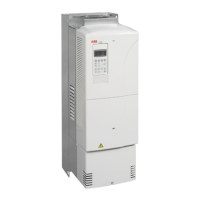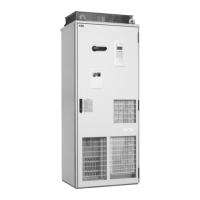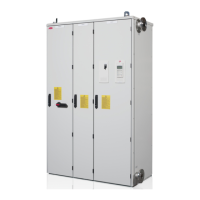Planning the electrical installation
51
Selecting the power cables
General rules
Dimension the mains (input power) and motor cables according to local
regulations:
• The cable must be able to carry the drive load current. See chapter Technical
data for the rated currents.
• The cable must be rated for at least 70
°C (158 °F) maximum permissible
temperature of conductor in continuous use. For US, see Additional US
requirements.
• The inductance and impedance of the PE conductor/cable (grounding wire) must
be rated according to permissible touch voltage appearing under fault conditions
(so that the fault point voltage will not rise excessively when a ground fault
occurs).
• 600 V AC cable is accepted for up to 500 V AC. 750 V AC cable is accepted for
up to 600 V AC. For 690 V AC rated equipment, the rated voltage between the
conductors of the cable should be at least 1 kV.
For drive frame size R5 and larger, or motors larger than 30 kW (40 hp), symmetrical
shielded motor cable must be used (figure below). A four-conductor system can be
used up to frame size R4 with up to 30 kW (40 hp) motors, but shielded symmetrical
motor cable is always recommended. The shield(s) of motor cable(s) must have
360° bonding at both ends.
Note: When continuous metal conduit is employed, shielded cable is not required.
The conduit must have bonding at both ends as with cable shield.
A four-conductor system is allowed for input cabling, but shielded symmetrical cable
is recommended. To operate as a protective conductor, the shield conductivity must
be as follows when the protective conductor is made of the same metal as the phase
conductors:
Compared to a four-conductor system, the use of symmetrical shielded cable
reduces electromagnetic emission of the whole drive system as well as the stress on
motor insulation, bearing currents and wear.
The motor cable and its PE pigtail (twisted shield) should be kept as short as
possible in order to reduce high-frequency electromagnetic emission, as well as
stray currents outside the cable and capacitive current (relevant in power range
below 20 kW).
Cross-sectional area of the phase
conductors
S (mm
2
)
Minimum cross-sectional area of the
corresponding protective conductor
S
p
(mm
2
)
S <
16 S
16 < S <
35 16
35 < S S/2

